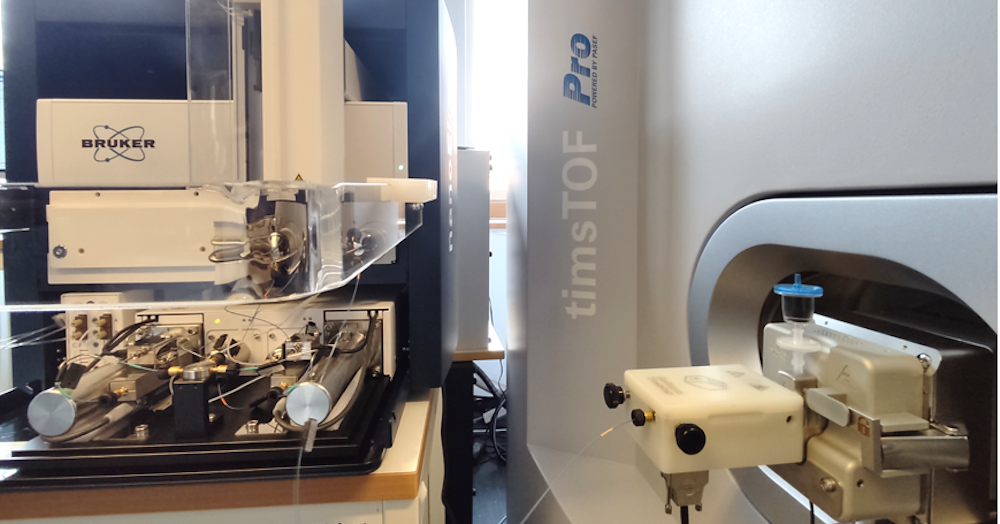Booking and prices
Booking:
Please contact the facility manager.
Contact information:
Facility Manager: Bernd Thiede
Location: Blindernveien 31
0371 OSLO
Norway
Instruments:
- UHPLC-TimsTOF Pro mass spectrometer
- UHPLC-Q Exactive mass spectrometer
- MALDI-TOF/TOF mass spectrometer
Techniques:
- SDS-PAGE:
Protein separation and staining in preparation for further analysis. Either complete lanes or selected bands of interest can be analyzed. It can be offered in two different sizes (6 cm or 10 cm). Staining with Coomassie G-250 is ideally suited in combination with mass spectrometry. - Lysis and protein precipitation:
For in-solution digests, proteins must be extracted from cells and tissues and purified by precipitation to remove contaminants (e.g., buffers, detergents etc.) which would disturb digestion. - In-gel and in-solution digestion of proteins:
Protein identification is usually done after generation of tryptic peptides. Trypsin is ideally suited to mass spectrometry, because of the average size of the peptides, charge state, and specificity of the enzyme. For in-solution digestion, reductive alkylation is performed before using trypsin for unfolding and denaturation of the proteins in 6M urea. We purify our peptide samples with C18-ZipTips to avoid problems with sensitivity and LC and MS instrumentation. - Stable isotopic peptide labeling and sample clean-up:
For non-cultured cells, chemical labeling is a commonly used method for MS-based quantitative proteome analysis using labeling. Lys-C peptides can be labelled applying isobaric peptide termini labelling (IPTL). Label-free quantification (LFQ) does not require any labeling. - Phosphopeptide enrichment:
For large-scale phosphoproteomics experiments, large starting material is required (> 1 mg). After digestion of the proteins with trypsin, the phosphopeptides are enriched with TiO2 beads. - Protein identification by MALDI mass spectrometry (Ultraflex II):
Protein identification. Relatively pure samples (up to 3 proteins) can be easily and rapidly analyzed by MALDI-MS. The samples are often derived from 2D gels. - UHPLC-ESI-MS (LTQ Orbitrap XL-ETD or Q Exactive):
Protein identification. Complex samples must be further purified by nanoLC (300 nl/min or less) before analysis by MS. An UHPLC is directly connected to the Orbitrap instruments and allows fast, highly sensitive and robust analysis with high mass accuracy (< 5 ppm). Usually, the samples derive from SDS-PAGE gel bands or after in-solution digestion. LC gradient times are dependent on the complexity of the sample. ETD is particularly suitable or the analysis of labile posttranslational modifications (e.g., glycopeptides). Note: The LTQ-Orbitrap instrument is fast, highly sensitive and robust and with high mass accuracy (< 5 ppm) in MS1 mode. The Q Exactive instrument is even faster and has high mass accuracy at MS1 and MS2 mode. The data are usually searched using the mass search program Mascot and provided as Scaffold file (Scaffold viewer can be freely downloaded on any PC). Please consider that the data analysis is based on probability scores and must be checked carefully. - MaxQuant data analysis:
Label free quantification (LFQ), chemical labelling of peptides (dimethylation, DiMe) and stable isotope labeling with amino acids in cell culture (SILAC) are frequently used methods for MS-based relative quantitative proteome analysis. MaxQuant is a software program that automatically quantifies several hundred thousand peptides per SILAC experiment and allows statistically robust identification and quantification of proteins. -
Top-down analysis:
Top-down proteomics is a method of protein identification that uses a mass spectrometer to store isolated intact protein ions for mass measurement and fragmentation by tandem mass spectrometry (MS2). The analysis of intact proteins using MS provides information on protein species arising from amino acid modifications, gene variants, transcript variation, signal peptide cleavages, and PTMs.
Description of services:
- Consultation, feedback and sample delivery (bernd.thiede@ibv.uio.no)
- Protein separation and staining
- Lysis and protein precipiation
- In-gel and in-solution protein digestion and sample clean-up
- Stable isotopic peptide labelling and sample clean-up
- Phosphopeptide enrichment
- Protein identification by MALDI-MS
- LC-MS analysis
- Protein quantification (SILAC, LFQ, dimethylation and IPTL)
- Scaffold, MaxQuant and IsobariQ data analysis
- Top-down analysis
Price list:
| Service | Method | Instrument | Unit | Price UiO | Price academic | Price commercial |
|---|---|---|---|---|---|---|
|
Protein separation |
SDS-PAGE/ Coomassie G-250 |
Mini Protean |
Gel | 500 | 600 (750) | 1000 (1250) |
| Lysis |
Homogenisation |
Sample | 400 | 480 (600) | 800 (1000) | |
|
Protein precipitation |
Cold acetone | Sample | 100 | 120 (150) | 200 (250) | |
|
In-solution digestion |
DTT, IAA, DTT, trypsin & SPE-C18 |
Sample | 400 | 480 (600) | 800 (1000) | |
|
In-gel tryptic digestion |
Trypsin & SPE-C18 |
Sample | 400 | 480 (600) | 800 (1000) | |
|
Phosphopeptide enrichment |
TiO2 beads |
Sample | 1000 | 1200 (1500) | 2000 (2500) | |
|
MALDI-MS analysis |
MALDI-MS |
Ultraflex II |
Sample | 200 | 240 (300) | 400 (500) |
|
Protein identification by MALDI-MS |
MALDI-MS & DB search |
Ultraflex II |
Sample | 300 | 360 (450) | 600 (750) |
|
LC-MS analysis |
NanoUHPLC, ESI-MS/MS & DB search |
UHPLC/ TimsTOF Pro or Q Exactive |
|
|
|
|
Prices in NOK, UiO, University of Oslo, Price in parentheses = including MVA (25%) Price list valid from October 1, 2022
